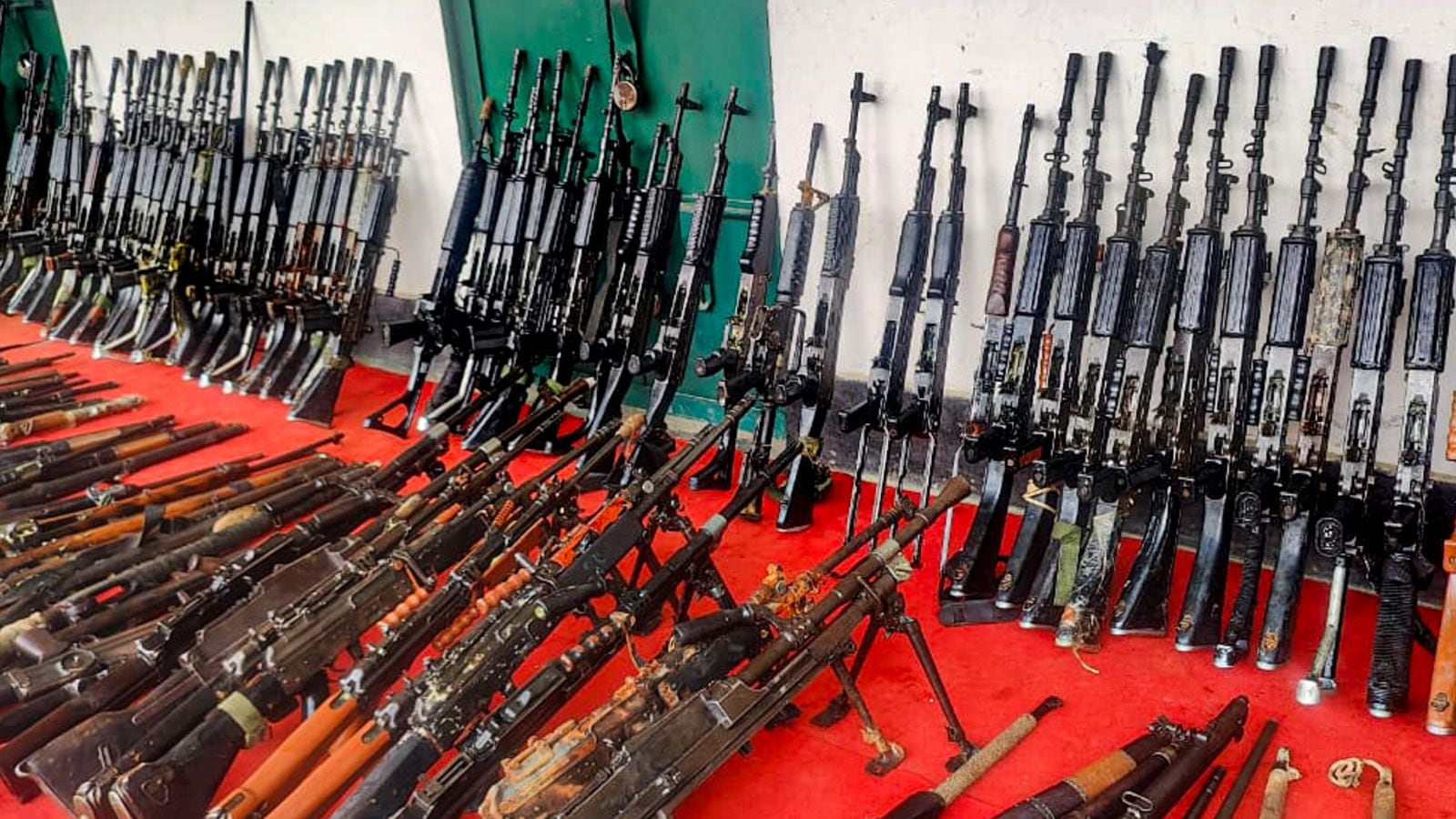Over 650 Militants Arrested, 3,134 Weapons Recovered Under President’s Rule in Manipur
Short summary
Since President’s Rule was imposed in Manipur on 13 February 2025, security agencies say they have arrested over 650 cadres from various proscribed outfits and recovered about 3,134 weapons of different kinds across the state — a figure released in recent reporting that points to an intensive arms-recovery and counter-insurgency campaign under the Centre’s direct rule. The state assembly remains under suspended animation while the central government keeps President’s Rule in place until 13 February 2026, citing the fragile law-and-order situation
Opening — big figures, bigger questions
Numbers have a way of looking decisive on paper. “650 arrests” and “3,134 weapons” read like a headline victory: enforcement is active, caches are shrinking, and danger seems measurable. But numbers also beg questions: who were arrested, what exactly was recovered, how reliable are the tallies, and — most importantly — does this hard policing translate into durable peace for communities battered by years of ethnic violence and instability? In Manipur’s case, the answers are complicated. The recent report of mass arrests and weapons recoveries is an important data point — but it’s one piece of a much larger puzzle that includes displaced civilians, missing firearms from the 2023 unrest, drug trafficking, and the need for political, social and judicial fixes.
The headline facts — what was reported
Local reporting (Nenow) states that since President’s Rule began, security forces have arrested over 650 militants and recovered approximately 3,134 weapons of various types across the state. President’s Rule was first imposed on 13 February 2025 after the state government collapsed amid continuing violence, and the Centre later extended it until 13 February 2026, citing the precarious security climate. These figures come from official briefings and consolidation of multiple recovery operations conducted by Manipur Police and central security forces.
Why these numbers matter
On first glance, large recovery figures suggest a clear operational win: fewer guns in circulation should equal fewer attacks. But the reality has shades. Manipur’s modern crisis stems from ethnic clashes that began in May 2023, during which thousands of firearms were looted or went missing. Authorities have long warned that illicit arms remain a major risk. Recovering 3,134 weapons is a major logistical and intelligence achievement — it reduces available stockpiles — but it doesn’t automatically restore trust in institutions, nor does it immediately make displaced families feel safe to return home. Weapons recovery helps, but peace needs post-conflict reconciliation, return of property, and socio-economic rebuilding.
What kinds of weapons are we talking about?
The recovered arms are reported to include a wide spectrum: rifles (AK-series, INSAS), pistols, shotguns, grenades, improvised explosive devices (IEDs) and anti-riot arms noted in some operations. Media reports across outlets in recent months have detailed seizures of dozens to hundreds of firearms in separate raids — for example, one joint operation recovered 86 firearms and nearly 1,000 rounds in July, while other coordinated operations recovered additional caches and IED components. Those recoveries are consistent with the broader tally cited in the President’s Rule report. Each weapon removed reduces tactical options for armed actors, but some caches still remain unaccounted for and the provenance (local theft vs cross-border smuggling) matters for prevention strategies.
Arrests: cadres, rank-and-file, or leaders?
“Over 650 militants arrested” is a headline-sized claim, but who exactly were these people? Reports indicate a mix: active cadres of proscribed outfits, alleged foot soldiers, local recruiters, and link-men — not necessarily always senior commanders. In many counter-insurgency campaigns, authorities prioritize disrupting networks (logistics, arms, recruitment) rather than capturing only top leadership; dismantling the ecosystem reduces operational capacity. Still, if leadership or external sanctuaries remain intact, groups can regenerate. Thus, while widespread arrests reduce immediate threat, long-term success depends on whether networks are fatally disrupted or merely weakened temporarily.
Examples from recent raids — how recoveries add up
The large headline numbers are the sum of many individual operations. In July and early August, multiple raids across Imphal East, Imphal West, Thoubal, Bishnupur and other districts resulted in seizures of dozens of guns, grenades and IEDs. For instance, one operation recovered 86 firearms and 974 rounds, another seized 155 weapons and IED components, and multiple smaller busts added to the overall tally. These operations often combine local police, central armed police forces and intelligence leads to systematically comb through suspected caches — a process that can reveal hidden dens, arms drop points, and supply lines
Final thoughts — cautious optimism, rooted in hard work
The headline numbers — 650+ arrests and 3,134 weapons recovered — are not trivial. They show active security effort and meaningful seizures. But they are a starting point, not a finish line. True stabilization of Manipur requires converting those tactical wins into legal closures, community healing and economic revival. The security gains give breathing room; how leaders — central and local — use that time to rebuild trust and infrastructure will decide whether these figures become the first chapter of lasting peace or the prelude to another cycle of unrest.
Five FAQs
Q1: Are the “over 650 arrests” all confirmed militants?
A1: Reports say they are cadres linked to proscribed outfits, but the detained group likely includes a range of roles (operatives, link-men, recruiters). Each arrest must be legally processed to determine individual culpability.
Q2: Do the recovered weapons include those looted during the 2023 violence?
A2: Some recovered arms likely include looted weapons from earlier unrest, and other seizures involve smuggled or locally stored arms; tracing origins is part of forensic and intelligence work.
Q3: Has violence decreased since President’s Rule began?
A3: Officials report a dip in some types of incidents and cite major seizures, but measuring decline requires looking at verified fatality and displacement statistics over months — not just short-term operational gains.
Q4: Will President’s Rule end soon?
A4: The Centre has extended President’s Rule until 13 February 2026; any earlier return to elected governance will depend on demonstrable improvements in security, public confidence and political consensus.
Q5: What should local communities demand now?
A5: Communities should press for transparent investigations, timely legal action against suspects, concrete plans for safe return and restitution, improved local policing with community oversight, and investment in livelihoods — all measures that make security gains meaningful and sustainable.






